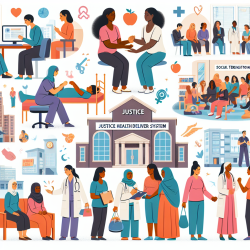Introduction
Justice-involved women face numerous challenges upon reentry into their communities, often requiring a complex array of services to support their health and well-being. The narrative review titled "The role of the community health delivery system in the health and well-being of justice-involved women: a narrative review" offers valuable insights into the fragmented nature of the Community Health Delivery System (CHDS) and its impact on these women.
Understanding the Community Health Delivery System
The CHDS encompasses a broad spectrum of justice, social, and healthcare organizations that collectively aim to improve the health and well-being of justice-involved women. However, the system is often fragmented, leading to inefficiencies and unmet needs. The review identifies three primary domains within the CHDS:
- Justice Organizations: These include parole and probation departments, courts, and law enforcement agencies. They play a critical role in setting conditions for successful reentry but often lack coordination with other service providers.
- Social Service Organizations: These agencies provide essential services such as housing, child welfare, and employment support. However, justice-involved women often face barriers in accessing these services due to systemic issues and social stigma.
- Healthcare Organizations: Healthcare services are crucial for addressing the physical and mental health needs of justice-involved women. Yet, there is a significant gap in continuity of care from incarceration to community reentry.
Recommendations for Practitioners
Practitioners working with justice-involved women can enhance their outcomes by implementing the following strategies based on the review's findings:
- Foster Interagency Collaboration: Encourage collaboration between justice, social, and healthcare organizations to create a more integrated and seamless service delivery system.
- Focus on Continuity of Care: Develop strategies to ensure that healthcare services initiated during incarceration continue post-release, reducing the risk of recidivism and improving health outcomes.
- Advocate for Policy Change: Work towards policy reforms that remove barriers to accessing social services and healthcare, particularly those related to housing and employment.
- Utilize Data-Driven Approaches: Implement evidence-based practices and track outcomes to continually improve service delivery and address gaps in the CHDS.
Encouraging Further Research
While the narrative review provides a comprehensive overview of the CHDS, further research is needed to explore the following areas:
- Integration of Services: Investigate effective models for integrating services across the CHDS to enhance coordination and resource allocation.
- Barriers and Facilitators: Identify specific barriers and facilitators within the CHDS that impact justice-involved women's access to care and services.
- Impact of CHDS on Health Outcomes: Conduct longitudinal studies to assess the long-term impact of CHDS services on the health and well-being of justice-involved women.
By addressing these areas, practitioners and researchers can contribute to a more effective CHDS that supports the successful reintegration of justice-involved women into their communities.
To read the original research paper, please follow this link: The role of the community health delivery system in the health and well-being of justice-involved women: a narrative review.










